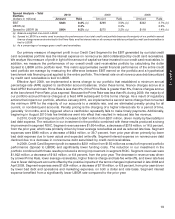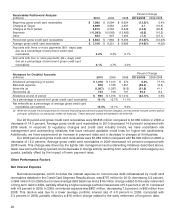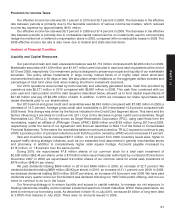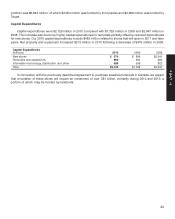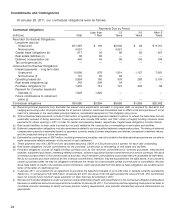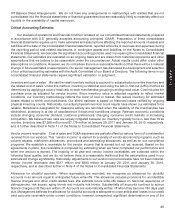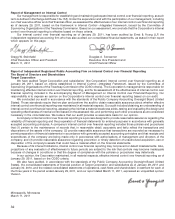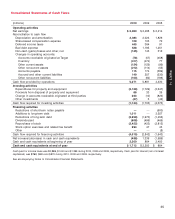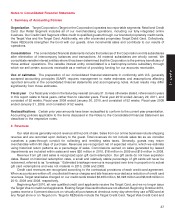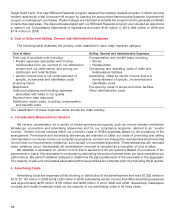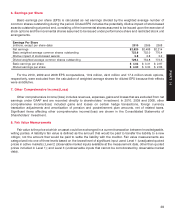Target 2010 Annual Report Download - page 51
Download and view the complete annual report
Please find page 51 of the 2010 Target annual report below. You can navigate through the pages in the report by either clicking on the pages listed below, or by using the keyword search tool below to find specific information within the annual report.
profitability, the allowance for doubtful accounts, improvement in portfolio risks, and the pursuit of a portfolio sale;
on a consolidated basis, details on the expected investment in Canada and its impact on our results, statements
regarding the adequacy of our sources of liquidity, the continued execution of our share repurchase program, our
expected capital expenditures and the number of stores to be opened in 2011, the expected effective income tax
rate, the expected compliance with debt covenants, our intentions regarding future dividends, our expected future
share-based compensation expense, our expected return on plan assets, our expected expense, contributions and
benefit payments related to our pension and postretirement health care plans, the adequacy of our reserves for
general liability, workers’ compensation, property loss, and team member medical and dental, the potential impact
of changes in our critical accounting estimates, the expected outcome of claims and litigation, and the resolution of
tax uncertainties.
All such forward-looking statements are intended to enjoy the protection of the safe harbor for forward-looking
statements contained in the Private Securities Litigation Reform Act of 1995, as amended. Although we believe
there is a reasonable basis for the forward-looking statements, our actual results could be materially different. The
most important factors which could cause our actual results to differ from our forward-looking statements are set
forth on our description of risk factors in Item 1A to this Form 10-K, which should be read in conjunction with the
forward-looking statements in this report. Forward-looking statements speak only as of the date they are made, and
we do not undertake any obligation to update any forward-looking statement.
Item 7A. Quantitative and Qualitative Disclosures About Market Risk
Our exposure to market risk results primarily from interest rate changes on our debt obligations, some of which
are at a LIBOR-plus floating rate, and on our credit card receivables, the majority of which are assessed finance
charges at a Prime based floating rate. To manage our net interest margin, we generally maintain levels of
floating-rate debt to generate similar changes in net interest expense as finance charge revenues fluctuate. The
degree of floating asset and liability matching may vary over time and in different interest rate environments. At
January 29, 2011, the amount of floating-rate credit card assets exceeded the amount of net floating-rate debt
obligations by approximately $2 billion. As a result, based on our balance sheet position at January 29, 2011, the
annualized effect of a 0.1 percentage point decrease in floating interest rates on our floating rate debt obligations,
net of our floating rate credit card assets and marketable securities, would be to decrease earnings before income
taxes by approximately $2 million. See further description in Note 20 of the Notes to Consolidated Financial
Statements.
We record our general liability and workers’ compensation liabilities at net present value; therefore, these
liabilities fluctuate with changes in interest rates. Periodically, in certain interest rate environments, we economically
hedge a portion of our exposure to these interest rate changes by entering into interest rate forward contracts that
partially mitigate the effects of interest rate changes. Based on our balance sheet position at January 29, 2011, the
annualized effect of a 0.5 percentage point decrease in interest rates would be to decrease earnings before income
taxes by approximately $10 million.
In addition, we are exposed to market return fluctuations on our qualified defined benefit pension plans. The
annualized effect of a one percentage point decrease in the return on pension plan assets would decrease plan
assets by $25 million at January 29, 2011. The value of our pension liabilities is inversely related to changes in
interest rates. To protect against declines in interest rates we hold high-quality, long-duration bonds and interest
rate swaps in our pension plan trust. At year-end, we had hedged approximately 55 percent of the interest rate
exposure of our funded status.
As more fully described in Note 14 and Note 26 of the Notes to Consolidated Financial Statements, we are
exposed to market returns on accumulated team member balances in our nonqualified, unfunded deferred
compensation plans. We control the risk of offering the nonqualified plans by making investments in life insurance
contracts and prepaid forward contracts on our own common stock that offset a substantial portion of our
economic exposure to the returns on these plans. The annualized effect of a one percentage point change in
market returns on our nonqualified defined contribution plans (inclusive of the effect of the investment vehicles
used to manage our economic exposure) would not be significant.
29
PART II


